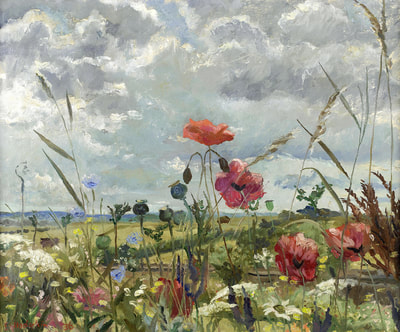|
'In so far as I have any conscious purpose, it is to show the beauty of natural objects which are normally thought uninteresting or even unattractive: such things as Brussels sprouts, turnips, onions, pebbles and flints, bulbs, dead leaves, bleached vertebrae, an old boot cast up by the tide. People sometimes tell me that they had never really ‘seen’ something before I painted it, and I should like to believe this… For myself, if I must put it into words, I try to look at quite simple things as though I were seeing them for the first time and as though no one had ever painted them before.' (Elliot Gould, The Studio Magazine, 1957) I came across the artist Elliot Hodgkin (1905-1987) the other day and felt an instant affinity towards him and his work. When first viewing his detailed paintings of leaves and other ephemera I immediately sensed a deep understanding of his need to capture the detail of the otherwise overlooked. His paintings portray such a close examination of natural ephemera ,growth, decay and the cycle of life with such sensitivity. His portrayal of light is beautiful and the subtle detail is exquisite. I could almost have spoken the above words myself said by Gould in an interview with The Studio Magazine in 1957. His catalogue of paintings is pretty extensive and with all, there appears to be such beautiful observation and realization. During the war he worked for the Home Intelligence Division of the Ministry of Information and also joined the A.R.P. (Air Raid Precautions) but still managed to keep painting between 1940 and 1944. He was drawn to the contrast between the ruins of bomb sites around London and the vegetation that grew within and out of them producing paintings on the subject. Starting off in oils, in later years he dedicated more of his time to painting in egg tempra after gaining a recipe for the medium from a friend. Beginning his work with detailed drawings of the work to be painted he would then trace the drawings onto primed hardboard.
Its not that often an artist makes such an impression on me but Hodgkins work has such a beautiful quality that I instantly fell in love with it. In a letter written to Sir Brinsley Ford, Hodgkin wrote: "I like to show the beauty of things that no one looks at twice." (http://www.eliothodgkin.com/biography-of-eliot-Hodgkin/ https://en.wikipedia.org/wiki/Eliot_Hodgkin)
0 Comments
The last couple of months has found me throwing myself back into a more considered exploration of this ever changing freezing process. Each making is hugely influenced by the ephemera sourced in the outdoor landscapes I inhabit. The seasons have always been a big influence on the work I produce and through careful regard of my surroundings it has always been important that the otherwise overlooked side of organic regeneration is represented; to reveal the unsuspecting beauty and fragility of growth and decay.
Careful observation of unintentional happenings, phenomena's and accidents while freezing and melting, drives more experimentation forward. Influenced by these material changes, intentional, intimate, intervention is applied in order to emphasise the formation of frost, ice, cracks, fissures and textures; the internal and external fabric of each piece. Their ephemeral individuality poses such a profound and unique existence that is only captured through photography. These pieces no longer exist in their physical form. From a teardrop to currently a more spherical form, planetary and celestial aspects have been a theme that interests me and visually produces some fabulous results. As seen above plant roots, the first autumnal leaves of the season, blackcurrants and willowherb are just some of the materials used within these many pieces. These works will continue to develop and surprise. ___________________________________________________ |































 RSS Feed
RSS Feed
